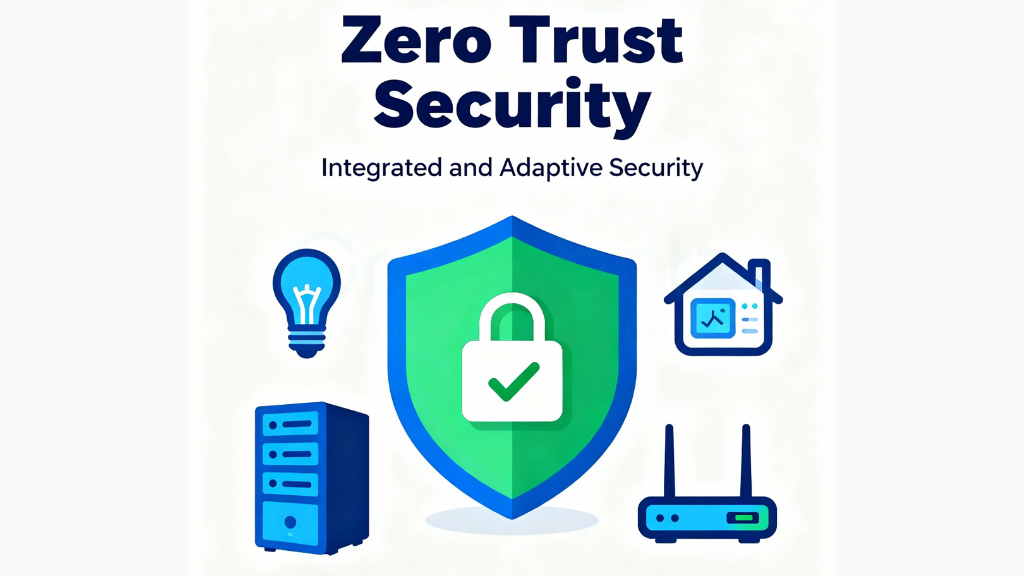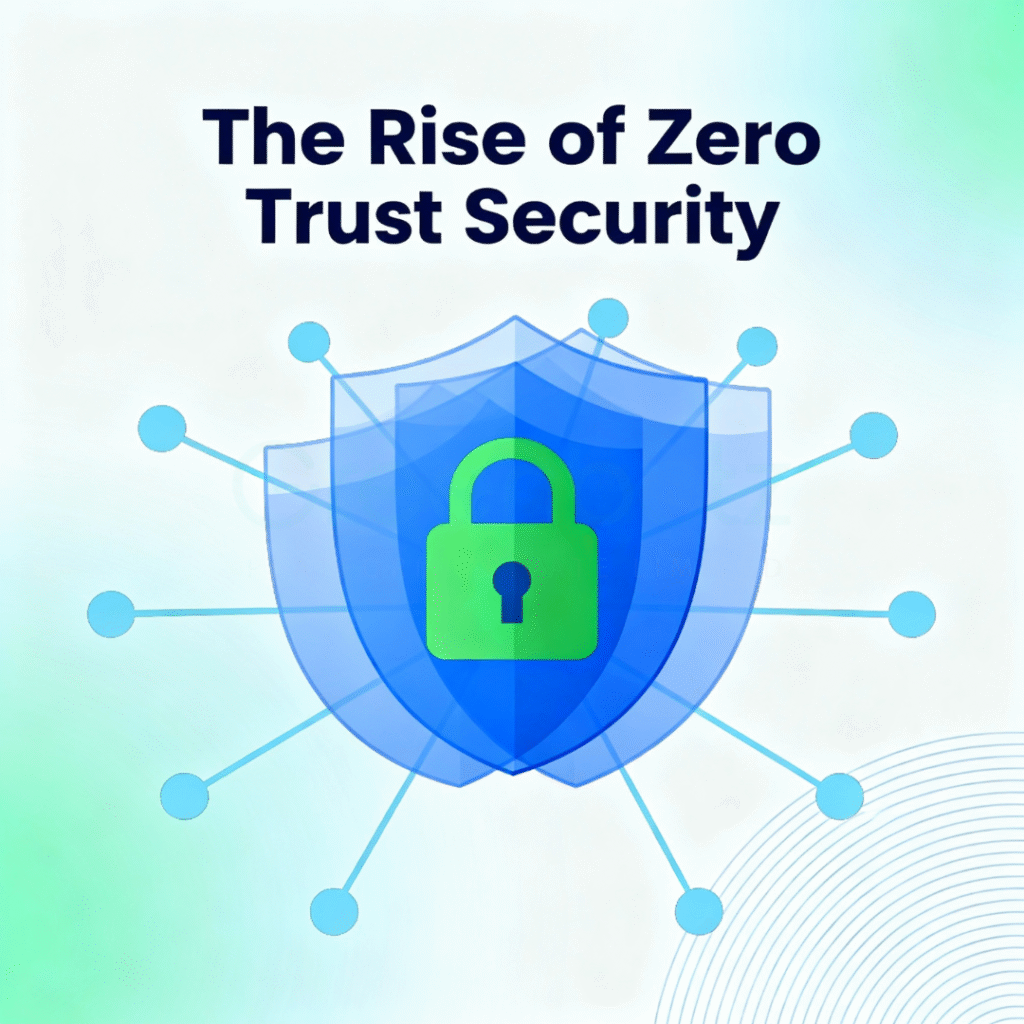The Rise of Zero Trust Security for Your Home and Business

In today’s hyper connected world, the traditional security model of building a digital wall around your home or business is no longer enough. The old “castle-and-moat” approach, where everything inside the network was trusted and everything outside was not, has become obsolete. With the rise of remote work, cloud services, and countless smart devices, the network perimeter has dissolved. The evolving digital landscape requires a new approach to cybersecurity a Zero Trust mindset.
The Zero Trust model operates on a simple but powerful principle: never trust, always verify. It assumes that threats can exist both inside and outside the network, so it treats every access request as a potential risk until proven otherwise. This article explores the rise of the Zero Trust framework, explaining what it means for your business data and your smart home, and how you can implement its principles to significantly improve your security posture.
What is a Zero Trust Architecture and Why Does it Matter?
A Zero Trust architecture is a security framework that requires all users, whether inside or outside the organization’s network, to be authenticated, authorized, and continuously validated before being granted access to applications and data. It’s a fundamental shift from trusting users and devices by default. Instead of asking, “Are you on my network?” it asks, who are you? What are you trying to access? Is your device secure? Should you have access at this moment? “
Zero Trust is built upon three foundational principles:
- Verify Explicitly: Always authenticate and authorize based on all available data points, including user identity, location, device health, and the resource being accessed.
- Use Least Privilege Access: Grant users only the bare minimum permissions they need to perform their specific tasks. This limits their access and minimizes the potential damage if their account is compromised.
- Assume Breach: Always operate under the assumption that a threat may already exist within your network. This mindset forces you to build defenses to contain threats and prevent them from moving laterally to access other systems.
By discarding the outdated notion of a “trusted internal network,” Zero Trust delivers a stronger, more adaptive defense against today’s sophisticated cyber threats.
Key Benefits of a Zero Trust Security Model
Adopting a Zero Trust framework offers significant advantages by fundamentally strengthening an organization’s security posture from the inside out. The primary benefits include:
- Reduced Attack Surface: By implementing microsegmentation and least privilege access, you drastically limit an attacker’s ability to move laterally within the network. If one segment is compromised, the breach is contained, preventing widespread damage.
- Enhanced Data Protection: Zero Trust focuses on securing the data itself, not just the network perimeter. Every access request is scrutinized, ensuring that only authorized users with secure devices can access sensitive information, which is critical for Business data protection.
- Improved Visibility and Analytics: The model requires continuous monitoring of all network activity. This provides rich data and insights, enabling Advanced threat detection and allowing security teams to quickly identify and respond to anomalous behavior.
- Secure Remote Access: In an era of hybrid work, Zero Trust provides a secure framework for a secure remote workforce access. It ensures that every user and device is verified, regardless of their location, protecting the corporate network from threats originating from unsecured remote environments.

Greenbotz and Zero Trust in Action
At Greenbotz, we integrate these Zero Trust principles directly into our security solutions to provide tangible, real-world protection. Here’s how our applications align with the core elements of a Zero Trust model:
| Zero Trust Element | Application |
| Identity & Access Management | The Biomex App enforces strict resident access control and visitor verification, ensuring only authorized individuals can enter the premises. |
| Network Microsegmentation | Our Smart Condo network design features isolated device communication, preventing a compromised device from affecting the entire network. |
Advanced Threat Detection
| We utilize AI-based anomaly detection in our VMS platforms to identify and flag suspicious activity in real-time. |
Least Privilege Policy
| Our systems provide role-based access for condo managers and residents, granting permissions tailored specifically to their required functions. |
IoT Device Security
| Smart Intercom and Home AI devices are secured with robust device authentication, ensuring every connected device is verified before it can communicate on the network. |
Implementing Zero Trust for Advanced Threat Detection and Business Data Protection
For businesses, the stakes have never been higher. A single breach can lead to devastating financial loss, reputational damage, and operational chaos. Embracing a Zero Trust architecture is no longer optional – it’s essential for ensuring robust business data protection.
Zero Trust Implementation in Your Organization
Implementing a Zero Trust framework is a strategic journey, not a single product purchase. It begins with identifying your most critical assets – your “protect surface” and mapping how data flows to and from them.
A key pillar of this strategy is Identity and Access Management (IAM). This serves as the foundation for enforcing a strict user access control policy, where every access request is challenged. Instead of a one-time login, Zero Trust demands continuous authentication. This is especially critical for enabling secure remote workforce access service edge, as it ensures that employees connecting from various locations are properly verified every time.
Another crucial component is Network Microsegmentation. This practice involves breaking down the network into small, isolated zones, each with its own security controls. If an attacker breaches one segment, they are contained and cannot move laterally across the network to access other sensitive data. This is a powerful tool for stopping ransomware and other advanced attacks in their tracks.
Finally, a mature Zero Trust environment relies on Advanced threat detection and analytics. By continuously monitoring user behavior, device health, and network traffic, security teams can spot anomalies and respond to potential threats in real-time before they escalate into full-blown breaches. These elements combine to create a dynamic and resilient security posture fit for modern enterprise security solutions.
From Enterprise to Entryway: Building a Secure Smart Home with Zero Trust Principles
The principles of Zero Trust aren’t just for large corporations; they are increasingly relevant for creating a Secure smart home. Your home network is now filled with dozens of connected devices smart TVs, speakers, cameras, and even refrigerators. Each one of these is a potential entry point for an attacker.
Your Guide to Better Home Network Security
Applying Zero Trust at home means treating every device and user with a healthy dose of skepticism. Don’t automatically trust that your new smart lightbulb has perfect security.
Your first line of defense is robust Home network security. Start by changing the default password on your Wi-Fi router to something long and unique. More importantly, create a separate “guest” network for your IoT devices and visitors. This acts as a form of microsegmentation, isolating potentially vulnerable smart gadgets from your primary network where your laptops and phones containing sensitive data reside.
Next, focus on Smart home user access. Enforce a strict personal policy for passwords – use a password manager to create strong, unique passwords for every single device and account. Enable two-factor authentication (2FA) wherever possible. This “verify explicitly” step ensures that even if someone steals a password, they can’t access your accounts.
An effective IoT device security policy for business and home involves limiting what your devices can do. Review the permissions for every app and smart device. Does your smart speaker really need access to your contacts? Does your security camera need an open connection to the entire internet? By restricting permissions, you apply the principle of least privilege, reducing your risk.
Achieving an All-in-One Home Security Posture
Ultimately, the goal is to achieve Online privacy protection and physical security simultaneously. A modern, All-in-one home security system should do more than just sound an alarm. It should act as a central command center for your digital and physical worlds, allowing you to monitor who is on your network, manage device access, and receive alerts about both physical and digital threats. This integrated approach is the key to improving your home’s overall security posture.
FAQ's
Isn't a strong firewall enough for my business?
No. While a firewall is an essential part of security, it primarily protects the perimeter. It does little to stop an attacker who uses stolen credentials to appear as a legitimate internal user. Zero Trust assumes threats can come from anywhere – inside or outside – and verifies every request accordingly.
Is Zero Trust too complicated for my home?
Not at all. You can apply the core principles easily. Using a guest network for smart devices, enabling 2FA on all your accounts, and using strong, unique passwords are all simple yet powerful steps that reflect a Zero Trust mindset.
What is the first step to implementing Zero Trust?
The first step is to identify what you need to protect. For a business, this means defining your “protect surface” – your most critical data, applications, and assets. For a homeowner, it starts with securing your Wi-Fi router, as it’s the gateway to your entire home network.
Does Zero Trust mean I can't trust my employees?
Zero Trust is not about a lack of personal trust; it’s a security model that removes the concept of implicit trust from technology systems. It protects both the company and its employees by making it much harder for an attacker to use stolen credentials to cause damage, thereby safeguarding everyone.
